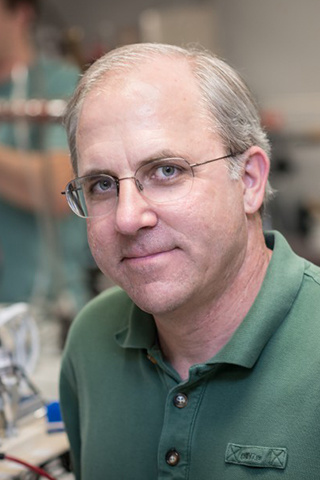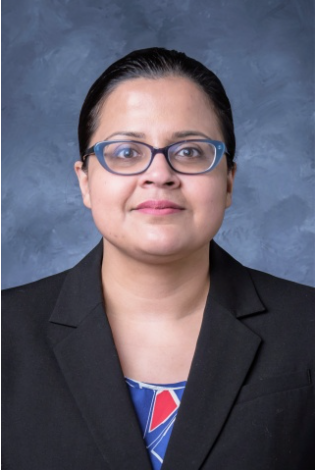University of Iowa Hospitals & Clinics was one of the first in the U.S. to use an innovative technology in a new way to extend the use of personal protective equipment (PPE), which is especially important in the COVID-19 pandemic. Now, it’s working with other leading medical centers around the country to refine the process, thanks to a partnership with the UI College of Public Health.
“This is just one example of what can happen when you combine ingenuity with world-class health care and academic expertise,” says Suresh Gunasekaran, chief executive officer of UI Hospitals & Clinics and associate vice president of UI Health Care. “We’re fortunate to have all those resources here in one place to help Iowans and people across the country.”

UI Hospitals & Clinics developed an N95 respirator decontamination process using a unique technology known as ionized hydrogen peroxide or SteraMist. The reprocessed equipment must meet safety standards; Patrick O’Shaughnessy, professor of occupational and environmental health in the UI College of Public Health, ensures that vital step is not overlooked.
O’Shaughnessy is a certified industrial hygienist and scientist who researches the efficacy of respirators and other protective equipment. He directs the UI Heartland Center for Occupational Health and Safety, one of 18 such centers funded by the National Institute for Occupational Safety and Health (NIOSH).
O’Shaughnessy recently confirmed that a further modification of the decontamination process developed by UI Hospitals & Clinics can safely reprocess N95 respirators up to six times without a significant reduction in functionality. The original process allowed up to four cycles of decontamination.
“He’s currently helping us refine our protocol to see if we can extend their useful life any more,” says Mike Hartley, emergency manager at UI Hospitals & Clinics, who helped lead development of the decontamination protocol. “He and the UI Heartland Center have been, and continue to be, critical players in this effort.”
Related content
An article from UI Health Care explains in detail the steps involved in safely reprocessing N95 masks.
O’Shaughnessy has created a four-part video series for the public to explain what types of respirators are available and how they capture particles, especially the coronavirus.
UI Health Care is collaborating with medical centers such as Cedars-Sinai, UCLA Health, Massachusetts General Hospital, the Dana-Farber Cancer Institute, and MIT Medical to work with the manufacturer to refine its process. It’s also following a customized logistics process to track the reprocessing and use of each N95 mask.
The reprocessing process used by UI Hospitals & Clinics is currently one of the methods described by the Centers for Disease Control and Prevention (CDC) under its crisis standards of care decontamination recommendations. Thanks to a collaboration of teams from UI Health Care Central Sterilizing Services, Emergency Management, Employee Health, the Program of Hospital Epidemiology, the State Hygienic Laboratory, and the College of Public Health, the hospital now has the capacity to reprocess about 1,000 N95 masks each day.
“It’s been a lot of work alone in the lab, but also very rewarding to be able to provide information that can be used to ultimately aid our health care workers who depend so much on PPE to maintain their good health during this pandemic,” O’Shaughnessy says.
“We’re extremely grateful to everyone involved in this effort and all the efforts to help keep our patients safe,” says Gunasekaran.
UI Engineering sensors assisting Mercy Hospital to decontaminate masks
The University of Iowa College of Engineering is also partnering with Mercy Iowa City to use specialized sensors to measure the amount of ultraviolet (UV) exposure needed to decontaminate protective masks. By utilizing a thermal sensor used in research by Fatima Toor, an assistant professor in the Department of Electrical and Computer Engineering, the amount of UV irradiance can be measured and optimized so that the masks can be sterilized for reuse, rather than discarded.

“Our equipment was able to determine the necessary exposure time to properly irradiate the masks,” says Toor. “The sensor also measured the variation of the UV dose across a physical space, helping to determine the best location to put the masks when exposing them to UV.”
Toor was contacted about her work by Joshua Eastvold, an emergency medicine physician at Mercy. Eastvold saw how frequently masks were being used and then thrown away due to contamination. Mercy has recently acquired a UV sterilization system, and Eastvold wanted to be sure that the system was properly irradiating the masks.
“When we acquired stronger UV lights and began using the system, we wanted to double-check our math to make sure that the masks were irradiated at the proper distance and for enough time,” says Eastvold. “What we learned was that our prediction of needing three to four minutes to virilize the masks was incorrect. We actually need 10 minutes.”
By identifying the minimal amount of time that the masks needed for decontamination, more masks can be sterilized each day for doctors, nurses, and other health care professionals who are supporting both COVID-19 patients and others seeking medical treatments.
The sterilized masks are often used in concert with N95 masks, to increase the level of protection. With Toor’s sensors and Mercy’s UV system in place, multiple masks have been sterilized and redistributed to Mercy’s staff over the past week.
“I was impressed that an emergency medicine physician contacted me for help to ensure that the sterilization procedure is done correctly,” says Toor. “This collaboration shows the value the university staff brings to the local community and Eastvold’s dedication to excellent service to his patients and colleagues.”